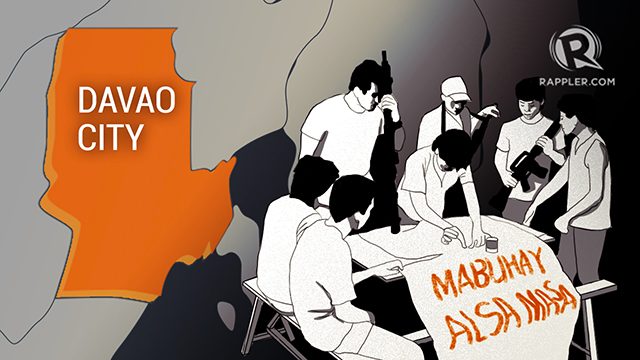SUMMARY
This is AI generated summarization, which may have errors. For context, always refer to the full article.

MANILA, Philippines – The Department of the Interior and Local Government (DILG) has unveiled a plan to combat the menace of crime and illegal drugs at the local level.
Interior Secretary Ismael Sueno said that the “Masa Masid” (People’s Watch) program would allow citizens to be more involved in eliminating drugs and crime at the barangay level by helping police gather intelligence and information, the Philippine STAR reported.
That program borrows from the concept of a vigilante group called Alsa Masa that started in the 1980s in Davao City.
In the case of Masa Masid, volunteerism and non-violence would prevail, said Sueno.
What is Alsa Masa?
The Alsa Masa (Masses Arise) was established as a vigilante group in 1984 by barangay captain Wilfredo “Baby” Aquino to combat the communist insurgency in Barangay Agdao, Davao City.
Back then, the New People’s Army (NPA) had honed in on Agdao and controlled the low-income settlement area. The place earned the monicker “Nicaragdao” after the Latin American country of Nicaragua which went through a similar experience.
Aquino was controversial himself, with William Chapman, author of Inside the Philippine Revolution, describing him as a “political overlord” in Agdao. A report by the Lawyers Committee for International Human Rights also noted that Aquino’s Alsa Masa “became notorious for its own lawless activities, including liquidations of suspected rebels.”
Baby Aquino was later assassinated, reportedly by NPA rebels.
Alsa Masa was then reorganized in 1986, with Rolando “Boy Ponsa” Cagay, who claimed to be a former NPA member, at the helm.
The new Alsa Masa had the support of then Lieutenant Colonel Franco Calida, who was the commander of the Davao City Metropolitan Command at the time. Radio broadcaster Jun Pala was linked to the group as its supposed spokesman, or the “Voice of Alsa Masa”. Some reports cite him as the group’s founder.
There were nearly 10,000 reported Alsa Masa members in Davao City, “including 3,000 former NPA members.”
These members conducted patrols in the city, operated checkpoints, collected intelligence for the police, and exercised the right of citizen arrest, reported US professor Ronald May in a study on vigilante groups.
“By mid-1987, Alsa Masa was credited with reversing the growth of NPA support in Davao (though others claim that the NPA had largely withdrawn from Davao by 1986),” added May.
Alsa Masa’s efforts versus the NPA in Davao City were commended by government, including then-President Corazon Aquino herself, who said that they serve as an “example” in fighting communism.
Abuses too
But Alsa Masa and other groups were also criticized for reported and human rights abuses. A Senate inquiry into vigilante groups in 1988 raised “a trend of escalating human rights violations against innocent civilians” and pointed out the apparent “legitimization” of these forces.
At the time, around 200 similar vigilante or paramilitary groups had sprouted with varying degrees of impact on their respective communities.
In July 1987, President Corazon Aquino ordered the dissolution of all paramilitary units, including the anti-insurgency Civilian Home Defense Forces (CHDF), via Executive Order 275.
Earlier that same month, she issued Executive Order 264, creating the Citizen Armed Force Geographical Units (CAFGU). Volunteers who are part of these auxiliary or reserve forces will be recruited and trained by the Armed Forces of the Philippines (AFP) to continue the fight against insurgents, and “will be subject to military law and the Articles of War.”
Then, in October 1987, the government provided guidelines on civilian volunteer self-defense organizations (CVSDO) or citizens’ volunteer organizations (CVO) that will be under local government supervision.
At the time, current President Rodrigo Duterte was acting vice mayor of Davao City. He was elected mayor in February 1988.
According to a report by Institute of Current World Affairs fellow Erik Guyot in August 1988, Duterte initially dismissed the birth of Alsa Masa as a “myth”. But when Duterte became the mayor, he lauded the group’s efforts against communism. (RELATED: Making sense of Digong Duterte) – Rappler.com
Sources: Alsa Masa: “Freedom Fighters” or “Death Squads?”, by Erik R. Guyot; Vigilantes in the Philippines: From Fanatical Cults to Citizens’ Organizations, by Ronald J. May; Militia Abuses in the Philippines, by James D. Ross; Inside the Philippine Revolution, by William Chapman; Human Rights Watch; globalsecurity.org
Illustration based from photo by Rene Lumawag.
Add a comment
How does this make you feel?
There are no comments yet. Add your comment to start the conversation.